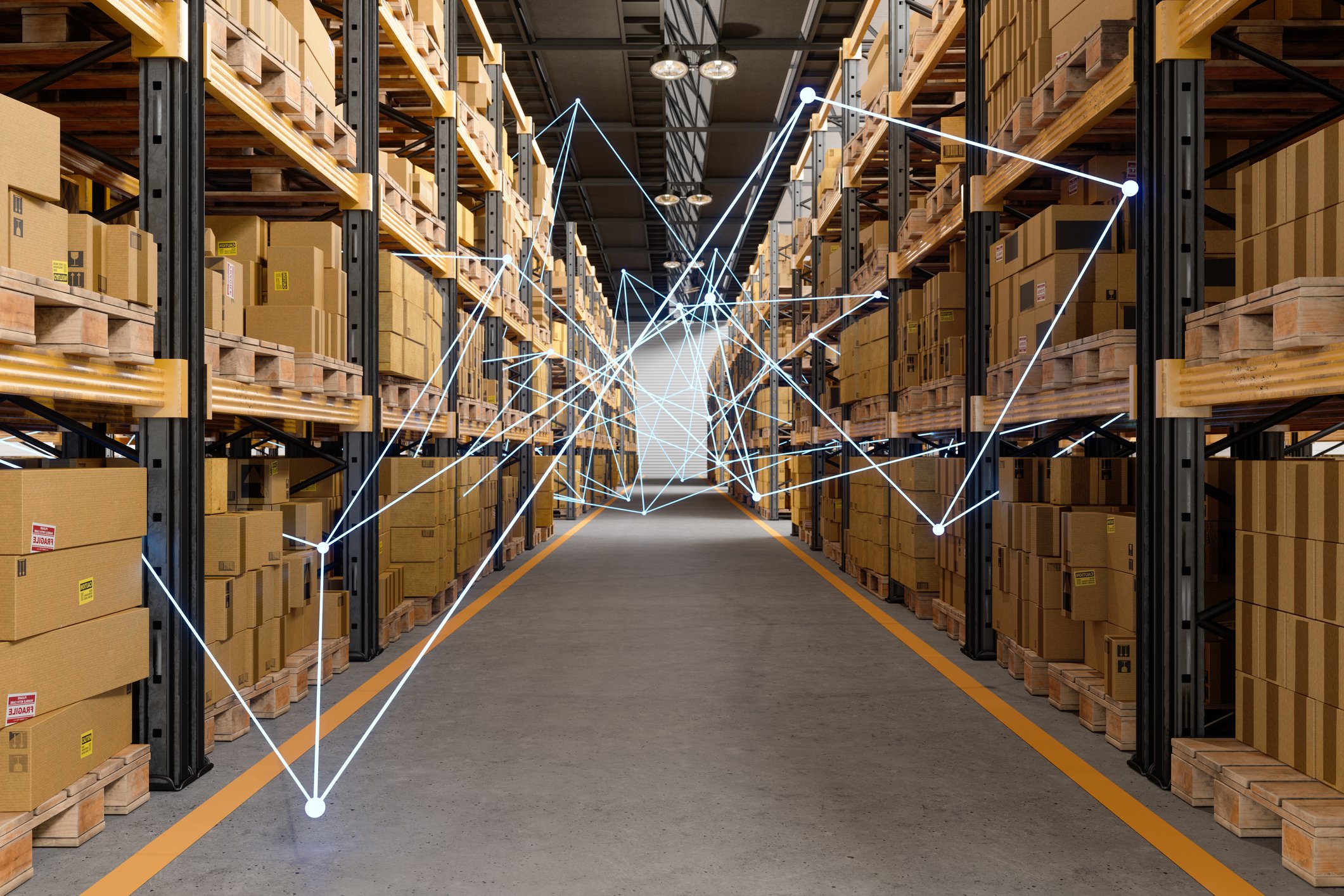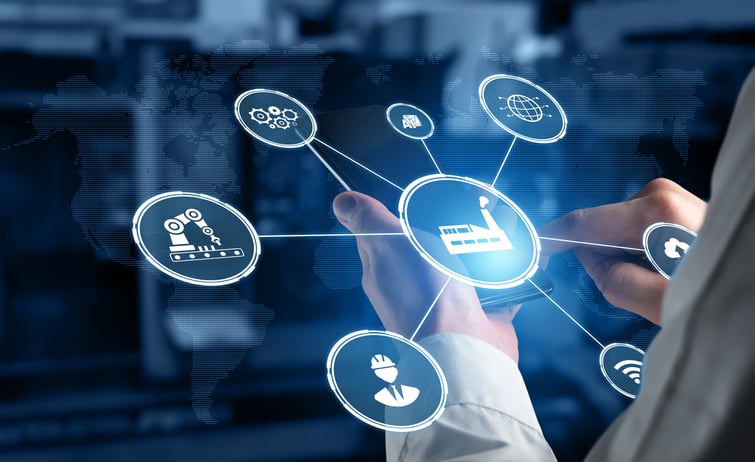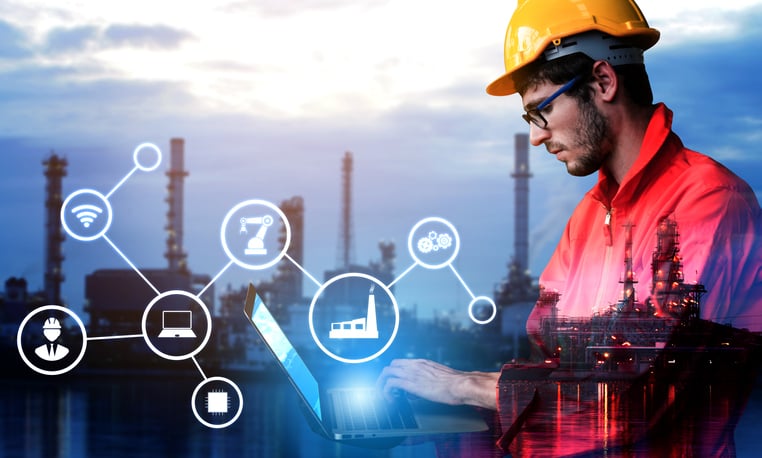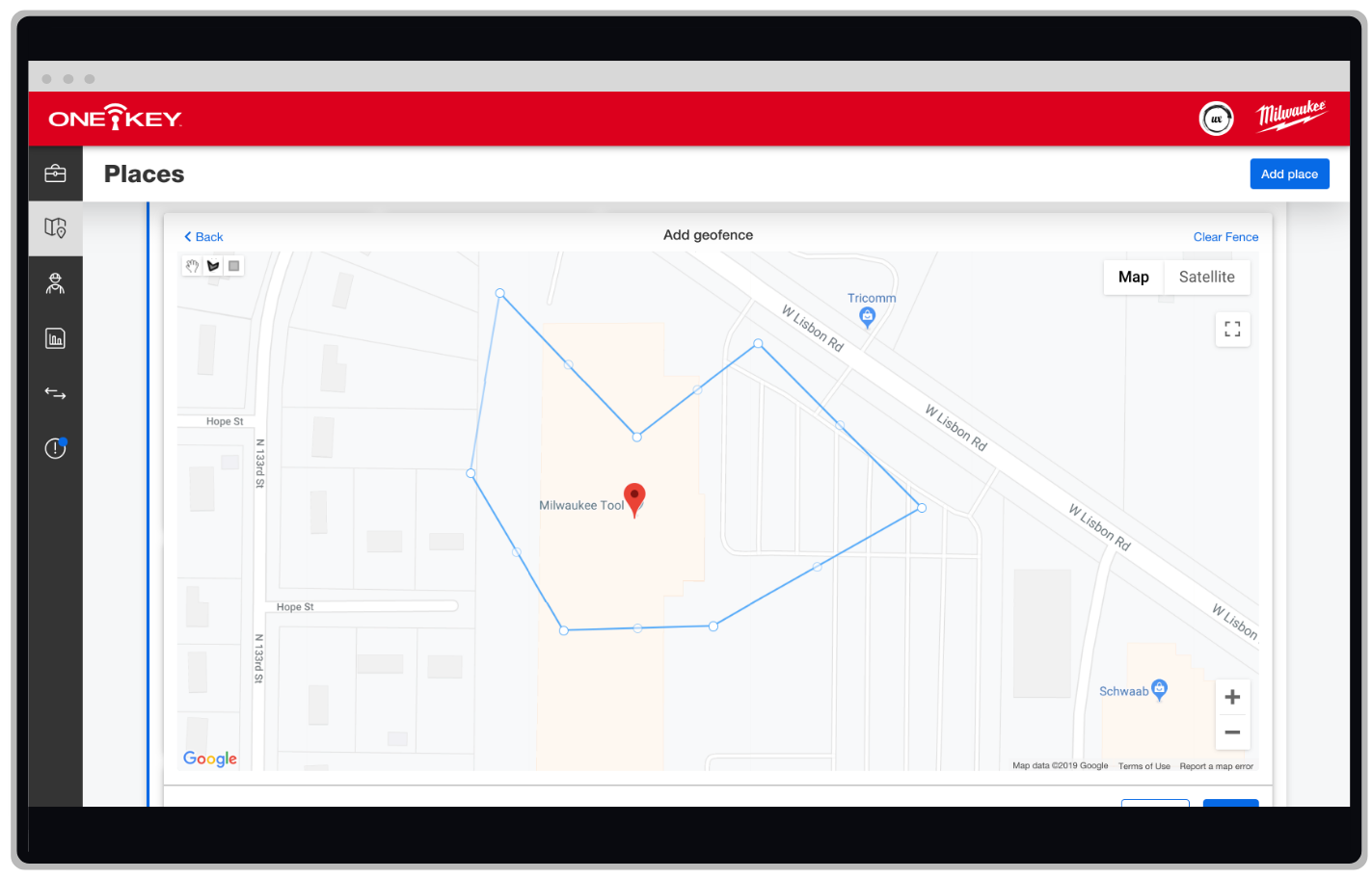 There are two internets.
There are two internets.
One of them is the familiar old internet you’re reading this article on; that vast archipelago of websites, social media, and streaming platforms where a growing number of people spend most of their waking lives. Then there’s the second internet, the one built not for people, but for things; a place where networks of human-made objects chatter back and forth like avatars on a message board.
Welcome to the Internet of Things (or IoT for short).
Lest you think it merely a corny buzzword, consider this: This secondary world wide web of objects is growing in size and value everyday. Consumer data company Statista estimates that by the end of 2018, there were already roughly 22 billion active devices connected to the IoT across the globe. And by 2030, that number is expected to more than triple to 75 billion devices, generating as much as $12.6 trillion in value, according to some estimates.
But what exactly is the Internet of Things? Where did it come from? What is it made of? And how is it useful in the world of construction? This article will answer all these questions and more.
Here's what lies ahead:
IoT Definition: What Exactly is the Internet of Things?
Splice the digital and physical worlds together and you get the Internet of Things.
As is the case with many technological concepts these days, the precise definition of the IoT depends on who you ask. For the sake of brevity, we’ll keep it simple. The IoT is what it sounds like: A network of individual objects of all types, shapes, and sizes that are connected to the internet. This interconnectivity is established by embedding these objects with sensors and computer chips that extend their functionality into the digital realm.

The reasons for creating these kinds of IoT or “smart” objects are many: Maybe you want to be able to track the location of an item as it moves through physical space. Perhaps you’re looking to automatically capture and analyze data within the surrounding environment. Or maybe you just want the ability to manipulate the object from afar, similar to how a remote is used to change the channel on your television.
There are many potential applications for IoT objects. Today, the umbrella of the IoT covers a vast swath of “smart” electronic appliances and consumer devices including light bulbs, watches, televisions, thermostats, refrigerators, speakers, security systems, outlets, essential oil diffusers–the list goes on and on. Many of these IoT objects can be controlled via voice activated hubs or with the swipe of a finger on your phone or tablet. The IoT has even penetrated into the world of construction, an industry that is known to be slow technological adopters.
At Milwaukee® Tool, we’ve traversed into the world of IoT through our ONE-KEY™ system and compatible smart tools, together which make up our IoT platform and represent our commitment to connectivity and innovation the trades can rely on.
We’ll expand on how the IoT is being deployed both on and off the jobsite in a moment. For now, let’s take a closer look at where this idea came from and how it’s evolved over time.
A Brief History of IoT
The world’s first IoT device, as it were, is believed to have been a Coca-Cola vending machine retrofitted in the early 1980s. A group of computer science grad students at Carnegie Mellon University wanted to use their computers to remotely keep track of how many cold Cokes were in-stock in the vending machine down the hall. Driven by their addiction to sugar and caffeine, they figured out a way to do just that by connecting the Coke machine to the ARPANET, the precursor to the modern internet created by the United States military.
It was around this time that the actual term “Internet of Things” first appeared in the lexicon. Its precise genesis, however, isn’t agreed upon. Some sources say Peter T. Lewis coined the term during a 1985 speech to the Congressional Black Caucus Foundation. Others place its origin almost 15 years later in 1999 during a presentation by Kevin Ashton. The story goes that the British tech entrepreneur came up with the concept while imagining using RFID (Radio frequency identification) chips to keep better track of a particularly elusive shade of brown lipstick. His idea of interconnected objects has since taken on a life of its own in the popular imagination, sometimes veering off in directions that Ashton isn’t exactly fond of.
“So you get stuff like the smart wine bottle, the smart bikini, and the smart water bottle,” Ashton said at the 2015 Reimagination Thought Leaders Summit. “This stuff is not the Internet of Things – this stuff is all rubbish.”
Even so, the IoT continued to evolve and expand as the advent of smartphones gave way to the eventual development of more and more devices capable of connecting to the internet. According to computer tech company Cisco, the IoT was officially “born” sometime between 2008 and 2009, when the number of connected devices outnumbered the number of people on Earth.
The Technologies Behind IoT
The IoT didn’t spring into the world fully formed. It was assembled and improved upon over time from a combination of other digital technologies, each acting as one in a series of pillars that keep the IoT afloat.

The IoT technologies we’ll explore below include:
- Smartphones
- Wi-Fi
- Cloud computing
- Ipv6
- GPS
- Bluetooth®
- RFID
- NFC
- Smartphones
It’s impossible to imagine the IoT without smartphones. The iPhone arrived in 2007, putting the internet in our pockets and laying the foundation for a more interconnected world. Nowadays, these multifunctional miniature computers are the command centers from which we access nearly every “smart” object on the market. In short: Smartphones are our eyes, ears, and steering wheels in the IoT.
- Wi-Fi
If smartphones are our windows into the IoT, then Wi-Fi is the spirit that animates it. IoT infrastructure relies entirely on the ability to establish persistent wireless connections between devices. Granted, the IoT creates these connections using a whole host of network protocols, but it’s undeniable that Wi-Fi is one of the most versatile and therefore most often utilized. Whether it’s a comprehensive smart home system or an inventory management platform out in the field, chances are you’re accessing it using Wi-Fi.
- Cloud-based computing
One of the major hurdles that the IoT needed to overcome was the low-computing power afforded to, say, a tennis shoe embedded with a microchip. Cloud based computing solves this problem by shifting the computational burden from the shoe to the internet itself. This way, the immense data storage and processing power required to impart “smartness” onto an object need not be limited by the design constraints of the object itself.
- IPv6
We’re venturing a little into the weeds on this next one. Smartphones, Wi-Fi, and the cloud are familiar enough, but IPV6? Don’t worry, we’ve got your back. So what is IPV6? In short, it’s an upgrade for the entire internet. Let’s start simple: The “IP” stands for Internet Protocol, which is basically the digital system that enables different computers–and IoT devices–in a network to communicate with one another. You know how your computer has an IP address that acts as a kind of digital identification card? Well, that IP address is associated with what’s called IP version 4, which is what the internet has been running on since the early 1980s. The problem is that IPv4 completely ran out of new IP addresses in November of 2019. As we’ve already touched on, the IoT is expected to explode in size over the next decade, and each IoT object is going to need its own IP address. To accommodate this massive incoming payload, we’re going to need a new protocol for the internet to run on. Enter IPv6, the latest version of the internet, which can handle 340 undecillion IP addresses. As it stands, roughly 25% of the internet currently runs on IPv6. We’ve still got a long way to go before we achieve total adoption, but it’s clear that IPv6 will play a significant role in the future of the IoT.
- GPS
The GPS, or Global Positioning Satellite system, makes it possible to track certain IoT objects over long distances. This is one of the fundamental capabilities that makes the IoT so enticing. The world is a big place and it’s easy to lose track of objects as they move between destinations. With GPS, users can pinpoint the locations of certain IoT objects, such as the GPS Smart Sole which can be used to keep track of elderly persons with dementia.
- Bluetooth®
Another essential pillar of IoT infrastructure is Bluetooth, the short-range wireless communication technology that connects your mobile device to nearly every IoT object imaginable, from your Airpods and videogame controllers to that newM18 FUEL™ Impact Wrench you've kitted and transferred to the job. With Bluetooth, you don’t need an internet or phone signal to be able to communicate with the assorted IoT devices in your arsenal. Bluetooth is also ideal for establishing quick links and sharing small pieces of information between devices.
- RFID
Let’s not forget RFID, the technology that kickstarted dreams of an Internet of Things in the first place. RFID is a great tool for warehouse and asset management. In the IoT, objects embedded with RFID tags are automatically detectable by RFID readers, which collect timestamp and location information within a specific radius.
- NFC
A descendant of RFID, NFC or Near Field Communication gives objects the ability to digitally communicate identifying information over extremely short distances of only a few centimeters or so. This capability is ideal for providing secure financial transactions and the small, low-power nature of NFC tags make it possible to quickly add “smartness” to pretty much any physical object in the environment.
The IoT in the World of Construction
The construction industry stands to benefit enormously from the IoT. Wearable tech like Augmented Reality smart glasses can improve training and increase safety on the jobsite. One of the most exciting applications is in the arena of asset and inventory management.
This is where we come in. At Milwaukee® Tool, we’ve dedicated ourselves to creating the industry’s most intuitive and easy-to-use app for tracking and managing your tools and equipment from the screen of your computer or mobile device. We call it One-Key. And did we mention that it’s free?

With One-Key, users are empowered to create their own personal Internet of Things. Using Bluetooth Low Energy (BLE) technology, One-Key lets you track where your assets are located within the physical environment. Features like geofencing will notify you when an asset is removed from a designated area, enabling the prevention of inventory loss or theft. The cloud-based One-Key platform also acts as a digital repository of information about each individual asset. Everything from operating manuals, maintenance schedules, and preferred settings can be stored and tweaked within the online space of One-Key.

It starts with our line of One-Key enabled power tools. These are Milwaukee brand tools that come with Bluetooth tags embedded into their frames. But One-Key doesn’t discriminate between different brands. Any tool big or small from any manufacturer can become “smart” and be tracked and managed within One-Key, thanks to our line of Bluetooth Tracking Tags. These small trackers can be screwed, glued, strapped, or zip-tied to any object you want to keep track of on or off the jobsite within a 300-foot range. Their durable construction is designed to be weatherproof and to withstand the working conditions of even the harshest construction sites. A QR code and built-in NFC chip allow the tags to be rapidly linked to a mobile device and cataloged in the One-Key app. Meanwhile, an onboard speaker makes it even easier to find lost items, allowing you to “ring” your tag from your phone within a 100-foot range.
Jobsites are safer and more efficient when they tap into the IoT. By enhancing the tools and materials of the trade with digital functionality, One-Key is expanding the horizon of what’s possible in the world of construction. The way we approach building the One-Key app and compatible IoT devices is one of interconnectivity; thinking deeply and systematically about how we can leverage data and better inform end users about their inflight projects and valuable equipment inventories through a network of securely interconnected devices. Whether that’s through Bluetooth® connectivity that allows users to see where their tools have been, find items in the vicinity, and remotely lock them out, or advanced, unlimited tool controls that allow you to dial in precise application-specific settings for torque repeatability, the applications for leveraging IoT for construction productivity are endless.
What Is the Future of IoT?
As an idea, IoT sits at the crossroads of several other concepts and technologies, many of which are on the cutting edge of the next frontier in digitalization. The much-lofted and as-of-yet unrealized twin ideas of mass-automation and Artificial Intelligence for instance all rely on the ability of technological objects and real-world infrastructure to communicate and coordinate actions between each other. Smart cities, driverless cars, City Information Modeling (CIM)—all of these multi-billion dollar technologies depend on the success of the IoT.
In this sense, the IoT has plenty of wind in its sails, but the wind says nothing of the rocky shores that still lie ahead. As it stands, there isn’t a single unified IoT so much as there are multiple disparate ones, with each company creating its own boutique network of smart objects only capable of talking to each other. One of the major concerns with the current state of affairs is security. Each IoT object in the wild represents a potential attack surface for an enterprising hacker, and recent research has shown that there are plenty of vulnerabilities waiting to be exploited. And to Ashton’s point about “smart bikinis”, the IoT has become muddied in recent years by products and applications whose value and purpose aren’t always readily apparent, or even seem to be absent from the picture altogether. By comparison, it’s almost intuitive that being able to keep better track of expensive power tools and heavy construction equipment can save contractors boatloads of time and money. But how exactly is something as simple as a water bottle or an egg tray improved in any meaningful way by connecting it to the internet?
The IoT is still a work in progress and it’s an open question whether or not it will ever transcend the sum of its parts. We of course feel that at least in the world of construction, the future of the IoT is bright. Building things is hard work, and it’s made all the harder when you don’t have a firm handle on the tools you need to get the job done. By managing and tracking your inventory with One-Key, you can finally begin to work smarter instead of harder.